356 books about North America and 10
start with H
356 books about North America and 10
356 books about North America
10 start with H start with H
10 start with H start with H

The Hall of the North American Indian
Change and Continuity
Hillel S. Burger
Harvard University Press, 1990
In 1990, the Peabody Museum reopened its Hall of the North American Indian, which since the late nineteenth century has displayed the most signifcant objects from the museum's vast Native American collections. In stunning full-page color photographs by Hillel Burger, this catalog captures the extraordinary richness of the collections.
[more]

Haudenosaunee Women Lacrosse Players
Making Meaning through Rematriation
Sharity L. Bassett
Michigan State University Press, 2024
Since the 1970s lacrosse has become one of the fastest-growing sports in North America, and Haudenosaunee communities have worked at the international level to claim lacrosse as an important part of Haudenosaunee culture and tradition. Lacrosse is also known as the medicine game as it is part of a medicine ceremony named in creation narratives and the Great Law of Peace that binds the six nations of the Haudenosaunee Confederacy Six Nations. The number of Haudenosaunee women and girls playing the sport has burgeoned since the 1980s. This book roots lacrosse as a Haudenosaunee sport both within and outside of these communities. It shows how the concept of rematriation—a culturally relevant framework that articulates the work Haudenosaunee peoples are doing to reconnect to the power imbued with matrilineal and matrifocal societies—situates Haudenosaunee women who play lacrosse within a complex understanding of contemporary, traditional, and medicinal lacrosse. Because they cannot seamlessly claim this as their medicine game, as the Haudenosaunee Nationals and other men’s teams do, Haudenosaunee women players must articulate some of the most nuanced understandings of tradition and medicine. These articulations connect to larger conversations within Haudenosaunee communities regarding the power that women hold and the rematriation of that power to define and uphold tradition. Haudenosaunee Women Lacrosse Players demonstrates how the cycle of action and articulation—with the intergenerational help of female leadership—firmly roots lacrosse within Haudenosaunee cultural fabric.
[more]
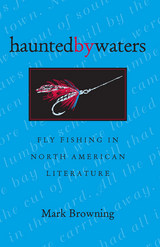
Haunted By Waters
Fly Fishing In North American Literature
Mark Browning
Ohio University Press, 1998
Four essential questions: Why does one fish? How should one properly fish? What relations are created in fishing? And what effects does fishing have on the future? Haunted by Waters is a self-examination by the author as he constructs his own narrative and tries to answer these questions for himself. But it is also a thorough examination of the answers he uncovers in the course of reading what's been written on the subject.
As his own story unfolds, Mark Browning analyzes angling literature from the Bible to Norman Maclean, always bringing his inquiry back to the same source: the enigma of this sport.
Haunted by Waters is an exploration of the apparent compulsion of those who fish not only to read about the sport, but to write about it as well. Mark Browning's personal account as a fly fisherman and his perspective as a critic make him uniquely qualified to navigate these waters.
As his own story unfolds, Mark Browning analyzes angling literature from the Bible to Norman Maclean, always bringing his inquiry back to the same source: the enigma of this sport.
Haunted by Waters is an exploration of the apparent compulsion of those who fish not only to read about the sport, but to write about it as well. Mark Browning's personal account as a fly fisherman and his perspective as a critic make him uniquely qualified to navigate these waters.
[more]
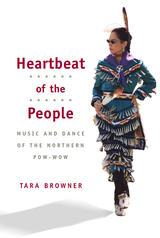
Heartbeat of the People
Music and Dance of the Northern Pow-wow
Tara Browner
University of Illinois Press, 2002
The intertribal pow-wow is the most widespread venue for traditional Indian music and dance in North America. Heartbeat of the People is an insider's journey into the dances and music, the traditions and regalia, and the functions and significance of these vital cultural events. Tara Browner focuses on the Northern pow-wow of the northern Great Plains and Great Lakes to investigate the underlying tribal and regional frameworks that reinforce personal tribal affiliations. Interviews with dancers and her own participation in pow-wow events and community provide fascinating on-the-ground accounts and provide detail to a rare ethnomusicological analysis of Northern music and dance.
[more]
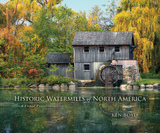
Historic Watermills of North America
A Visual Preservation
Ken Boyd
University of Alabama Press, 2021
112 full-color artistic photographs of watermills still standing on the North American landscape
The scenic beauty of the watermill is undeniable. The iconic waterwheel has inspired romantics for generations with their warmth and charm. Watermills were once ubiquitous landmarks along brooks, creeks, and rivers across North America. Today, only a scattering of the old watermills grace the countryside, but through these mills, and the turning of their wheels and the whirling of their stones, a small but spectacular part of history lives on.
Through stunningly beautiful images, Historic Watermills of North America: A Visual Preservation presents 112 watermills still standing on the North American landscape. With idealized full-color photographs, Ken Boyd nostalgically hearkens back to a time after European settlement when these structures were the very heart of the communities whose livelihoods they made possible. These mills turned the power of flowing water into mechanical energy to grind corn and wheat into meal and flour, saw timber, loom wool and cotton cloth, and more for the benefit of their operators and communities.
At one time vital to their surrounding regions, most of these surviving mills are in rural areas that have been passed over by modern development. Their designs are as individual as their makers, and their settings are as varied as the landscape. Some have been converted into homes or museums or are part of local tourist attractions. Others have been abandoned but give witness to the significance of their heydays, and others are still in use, doing the same work they have done for generations.
Boyd’s beautifully rendered photographs preserve these extant structures and represent a variety of watermills across the United States and Canada. Each mill photograph is accompanied by a description providing the name of the mill, its location, date of construction, and brief comments highlighting its most noteworthy features. Additional photographs and commentary in the afterword explore the inner workings of watermills.
The scenic beauty of the watermill is undeniable. The iconic waterwheel has inspired romantics for generations with their warmth and charm. Watermills were once ubiquitous landmarks along brooks, creeks, and rivers across North America. Today, only a scattering of the old watermills grace the countryside, but through these mills, and the turning of their wheels and the whirling of their stones, a small but spectacular part of history lives on.
Through stunningly beautiful images, Historic Watermills of North America: A Visual Preservation presents 112 watermills still standing on the North American landscape. With idealized full-color photographs, Ken Boyd nostalgically hearkens back to a time after European settlement when these structures were the very heart of the communities whose livelihoods they made possible. These mills turned the power of flowing water into mechanical energy to grind corn and wheat into meal and flour, saw timber, loom wool and cotton cloth, and more for the benefit of their operators and communities.
At one time vital to their surrounding regions, most of these surviving mills are in rural areas that have been passed over by modern development. Their designs are as individual as their makers, and their settings are as varied as the landscape. Some have been converted into homes or museums or are part of local tourist attractions. Others have been abandoned but give witness to the significance of their heydays, and others are still in use, doing the same work they have done for generations.
Boyd’s beautifully rendered photographs preserve these extant structures and represent a variety of watermills across the United States and Canada. Each mill photograph is accompanied by a description providing the name of the mill, its location, date of construction, and brief comments highlighting its most noteworthy features. Additional photographs and commentary in the afterword explore the inner workings of watermills.
[more]
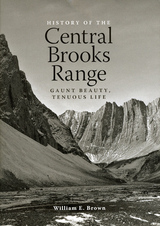
History of the Central Brooks Range
Gaunt Beauty, Tenuous Life
William E. Brown
University of Alaska Press, 2007
The History of the Central Brooks Range uses rare primary sources in order to provide a chronological examination and history of the Koyukuk region—including anthropological descriptions of the Native groups that make the Central Brooks Range and its surroundings their home. The history of early exploration, mining, and the Klondike all overflow into the story of the Koyukuk region and its rich cultural heritage, and William E. Brown provides a fascinating history of the extraordinary ways of survival employed by pioneers in this rugged northern land. Supplemented with detailed descriptions by Robert Marshall, The History of the Central Brooks Range is further enhanced by over 150 beautiful full-color illustrations—from early exploration to the creation of the Gates of the Arctic National Park—making this an essential volume for anyone interested in Alaska Native studies.
[more]
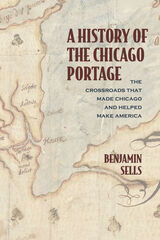
A History of the Chicago Portage
The Crossroads That Made Chicago and Helped Make America
Benjamin Sells
Northwestern University Press, 2021
Seven muddy miles transformed a region and a nation
This fascinating account explores the significance of the Chicago Portage, one of the most important—and neglected—sites in early US history. A seven-mile-long strip of marsh connecting the Chicago and Des Plaines Rivers, the portage was inhabited by the earliest indigenous people in the Midwest and served as a major trade route for Native American tribes. A link between the Mississippi River and the Atlantic Ocean, the Chicago Portage was a geopolitically significant resource that the French, British, and US governments jockeyed to control. Later, it became a template for some of the most significant waterways created in the nineteenth and twentieth centuries. The portage gave Chicago its name and spurred the city’s success—and is the reason why the metropolis is located in Illinois, not Wisconsin.
A History of the Chicago Portage: The Crossroads That Made Chicago and Helped Make America is the definitive story of a national landmark.
This fascinating account explores the significance of the Chicago Portage, one of the most important—and neglected—sites in early US history. A seven-mile-long strip of marsh connecting the Chicago and Des Plaines Rivers, the portage was inhabited by the earliest indigenous people in the Midwest and served as a major trade route for Native American tribes. A link between the Mississippi River and the Atlantic Ocean, the Chicago Portage was a geopolitically significant resource that the French, British, and US governments jockeyed to control. Later, it became a template for some of the most significant waterways created in the nineteenth and twentieth centuries. The portage gave Chicago its name and spurred the city’s success—and is the reason why the metropolis is located in Illinois, not Wisconsin.
A History of the Chicago Portage: The Crossroads That Made Chicago and Helped Make America is the definitive story of a national landmark.
[more]
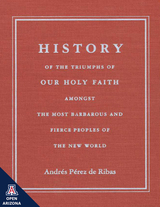
History of the Triumphs of Our Holy Faith amongst the Most Barbarous and Fierce Peoples of the New World
Andrés Pérez de Ribas; Translated by Daniel T. Reff, Maureen Ahern, and Richard K. Danford; Annotated and with a Critical Introduction by Daniel T. Reff
University of Arizona Press, 1999
Considered by historian Herbert E. Bolton to be one of the greatest books ever written in the West, Andrés Pérez de Ribas's history of the Jesuit missions provides unusual insight into Spanish and Indian relations during the colonial period in Northern New Spain. First published in Madrid in 1645, it traces the history of the missions from 1591 to 1643 and includes letters from Jesuit annual reports and other correspondence, much of which has never been found or cataloged in historical archives. Daniel T. Reff, Maureen Ahern, and Richard K. Danford have now prepared the first complete, scholarly, and fully annotated edition of this important work in English.
Pérez de Ribas was the first permanent missionary to the Ahome, Zuaque, and Yaqui Indians. After fifteen years on the mission frontier he was recalled to Mexico City, where he held various posts, including Jesuit Provincial. Addressed to novitiates ignorant of the challenges they would face in the field, his Historia was a virtual textbook on missionary work in the New World. Also written to encourage ongoing support of the Jesuit missions, it reflected the author's deep grasp of what rhetorically soothed and moved Church and Crown officials.
Perhaps of greatest interest to the modern reader are Pérez de Ribas's often detailed comments on indigenous beliefs and practices. These firsthand observations provide a rich resource of ethnographic and historical data concerning everything from native subsistence, settlement patterns, and myths to the dynamics of Jesuit-Indian relations. The many cases of conversion that Pérez de Ribas describes are especially rich in ethnographic data, clarifying the values and beliefs from which the Indians were "rescued."
History of the Triumphs is a primary document of great importance, made more valuable here by an exceptionally fluid translation and painstaking annotations. It will be a standard reference for all engaged in research on New Spain and a captivating read for anyone interested in this chapter of American history.
Pérez de Ribas was the first permanent missionary to the Ahome, Zuaque, and Yaqui Indians. After fifteen years on the mission frontier he was recalled to Mexico City, where he held various posts, including Jesuit Provincial. Addressed to novitiates ignorant of the challenges they would face in the field, his Historia was a virtual textbook on missionary work in the New World. Also written to encourage ongoing support of the Jesuit missions, it reflected the author's deep grasp of what rhetorically soothed and moved Church and Crown officials.
Perhaps of greatest interest to the modern reader are Pérez de Ribas's often detailed comments on indigenous beliefs and practices. These firsthand observations provide a rich resource of ethnographic and historical data concerning everything from native subsistence, settlement patterns, and myths to the dynamics of Jesuit-Indian relations. The many cases of conversion that Pérez de Ribas describes are especially rich in ethnographic data, clarifying the values and beliefs from which the Indians were "rescued."
History of the Triumphs is a primary document of great importance, made more valuable here by an exceptionally fluid translation and painstaking annotations. It will be a standard reference for all engaged in research on New Spain and a captivating read for anyone interested in this chapter of American history.
[more]
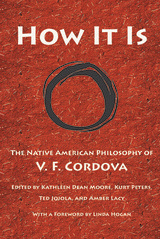
How It Is
The Native American Philosophy of V. F. Cordova
V. F. Cordova; Edited by Kathleen Dean Moore, Kurt Peters, Ted Jojola, and Amber Lacy, with a Foreword by Linda Hogan
University of Arizona Press, 2007
Viola Cordova was the first Native American woman to receive a PhD in philosophy. Even as she became an expert on canonical works of traditional Western philosophy, she devoted herself to defining a Native American philosophy. Although she passed away before she could complete her life’s work, some of her colleagues have organized her pioneering contributions into this provocative book.
In three parts, Cordova sets out a complete Native American philosophy. First she explains her own understanding of the nature of reality itself—the origins of the world, the relation of matter and spirit, the nature of time, and the roles of culture and language in understanding all of these. She then turns to our role as residents of the Earth, arguing that we become human as we deepen our relation to our people and to our places, and as we understand the responsibilities that grow from those relationships. In the final section, she calls for a new reverence in a world where there is no distinction between the sacred and the mundane.
Cordova clearly contrasts Native American beliefs with the traditions of the Enlightenment and Christianized Europeans (what she calls “Euroman” philosophy). By doing so, she leads her readers into a deeper understanding of both traditions and encourages us to question any view that claims a singular truth. From these essays—which are lucid, insightful, frequently funny, and occasionally angry—we receive a powerful new vision of how we can live with respect, reciprocity, and joy.
In three parts, Cordova sets out a complete Native American philosophy. First she explains her own understanding of the nature of reality itself—the origins of the world, the relation of matter and spirit, the nature of time, and the roles of culture and language in understanding all of these. She then turns to our role as residents of the Earth, arguing that we become human as we deepen our relation to our people and to our places, and as we understand the responsibilities that grow from those relationships. In the final section, she calls for a new reverence in a world where there is no distinction between the sacred and the mundane.
Cordova clearly contrasts Native American beliefs with the traditions of the Enlightenment and Christianized Europeans (what she calls “Euroman” philosophy). By doing so, she leads her readers into a deeper understanding of both traditions and encourages us to question any view that claims a singular truth. From these essays—which are lucid, insightful, frequently funny, and occasionally angry—we receive a powerful new vision of how we can live with respect, reciprocity, and joy.
[more]
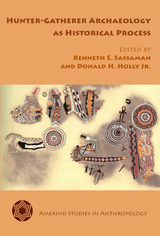
Hunter-Gatherer Archaeology as Historical Process
Edited by Kenneth E. Sassaman and Donald H. Holly Jr.
University of Arizona Press, 2011
The remains of hunter-gatherer groups are the most commonly discovered archaeological resources in the world, and their study constitutes much of the archaeological research done in North America. In spite of paradigm-shifting discoveries elsewhere in the world that may indicate that hunter-gatherer societies were more complex than simple remnants of a prehistoric past, North American archaeology by and large hasn’t embraced these theories, instead maintaining its general neoevolutionary track. This book will change that.
Combining the latest empirical studies of archaeological practice with the latest conceptual tools of anthropological and historical theory, this volume seeks to set a new course for hunter-gatherer archaeology by organizing the chapters around three themes. The first section offers diverse views of the role of human agency, challenging the premise that hunter-gatherer societies were bound by their interactions with the natural world. The second section considers how society and culture are constituted. Chapters in the final section take the long view of the historical process, examining how cultural diversity arises out of interaction and the continuity of ritual practices.
A closing commentary by H. Martin Wobst underscores the promise of an archaeology of foragers that does not associate foraging with any particular ideology or social structure but instead invites inquiry into counterintuitive alternatives. Hunter-Gatherer Archaeology as Historical Process seeks to blur the divisions between prehistory and history, between primitive and modern, and between hunter-gatherers and people in other societies. Because it offers alternatives to the dominant discourse and contributes to the agenda of hunter-gatherer research, this book will be of interest to anyone involved in the study of foraging peoples.
Combining the latest empirical studies of archaeological practice with the latest conceptual tools of anthropological and historical theory, this volume seeks to set a new course for hunter-gatherer archaeology by organizing the chapters around three themes. The first section offers diverse views of the role of human agency, challenging the premise that hunter-gatherer societies were bound by their interactions with the natural world. The second section considers how society and culture are constituted. Chapters in the final section take the long view of the historical process, examining how cultural diversity arises out of interaction and the continuity of ritual practices.
A closing commentary by H. Martin Wobst underscores the promise of an archaeology of foragers that does not associate foraging with any particular ideology or social structure but instead invites inquiry into counterintuitive alternatives. Hunter-Gatherer Archaeology as Historical Process seeks to blur the divisions between prehistory and history, between primitive and modern, and between hunter-gatherers and people in other societies. Because it offers alternatives to the dominant discourse and contributes to the agenda of hunter-gatherer research, this book will be of interest to anyone involved in the study of foraging peoples.
[more]
READERS
Browse our collection.
PUBLISHERS
See BiblioVault's publisher services.
STUDENT SERVICES
Files for college accessibility offices.
UChicago Accessibility Resources
home | accessibility | search | about | contact us
BiblioVault ® 2001 - 2024
The University of Chicago Press









